August 18 History Lesson (Day 326)
This morning dawned with rain threatening so we did some paperwork, cementing the last of our travel plans through Europe, while the rain came and finally slacked off. We took a walk back into the village center to stretch our legs.

Ski runs above town illuminated by the sun breaking through the receding rain clouds!
At Memorial Park, between the shopping center and the large church we found a pavilion with monuments and signage, and we got a WWII history lesson! Dombås at the time was an important rail and telegraph center linking north and south, from Trondheim to Oslo. During the German invasion of Norway in April of 1940, on April 21, the Dombås railway station was bombed by the Germans. The first American military casualty of WWII occurred in this bombing raid. While serving as a military attaché prior to America’s entry into the war, Robert M. Losey was killed … He had been attempting to complete the evacuation of the American diplomatic legation from Norway to Sweden in the wake of the German invasion.


The Dombås church, built in 1939, was spared by the Nazis.

A beautiful sunset on our way home. It is definitely feeling like autumn here in the mountains of Norway.
August 17 Dombås (Day 325)
Another train ride, another town! Today we traveled further south to the village of Dombås (pronounced ‘Doom-boss’), with a short stop in Trondheim which is the 3rd most populous city in Norway (Oslo #1, Bergen #2). Along the route we had many stops at small villages that boasted beautiful train depots.
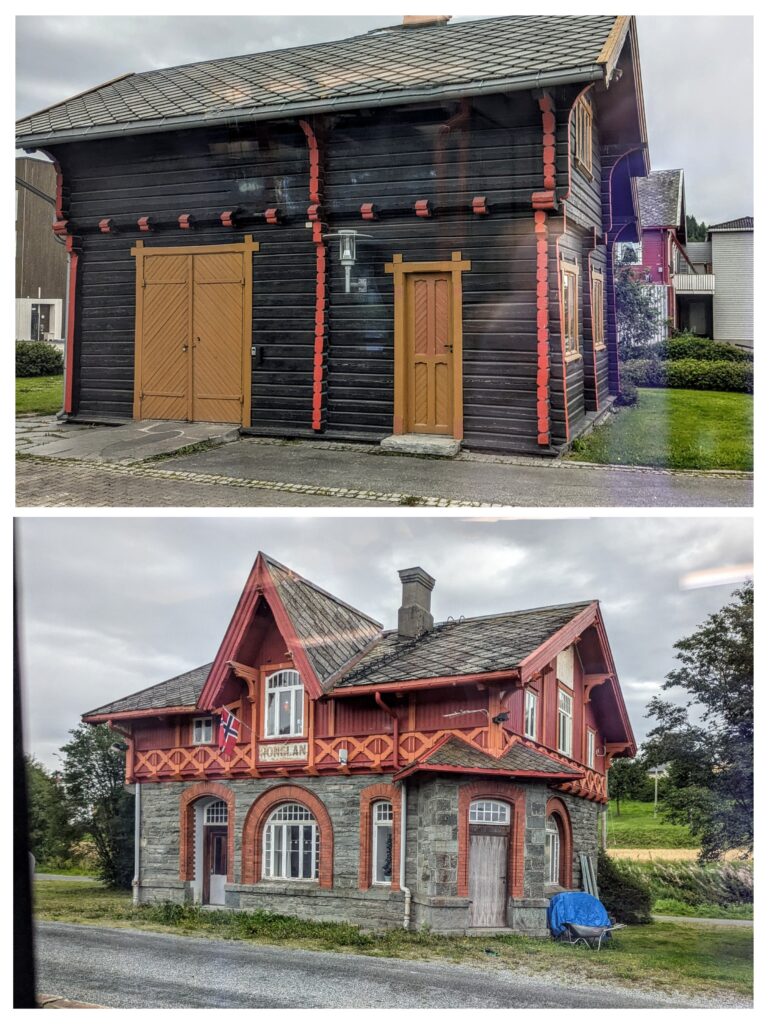
Some log buildings and some stone buildings.

And an unfortunate fire damaged depot.
Then the next stop was “Hell”!

The name Hell stems from the Old Norse word hellir, which means “overhang” or “cliff cave”. Among English-speaking tourists, popular postcards depict the station with a heavy frost on the ground, making a visual joke about “Hell frozen over”. Temperatures in Hell can reach −25 °C (−13 °F) during winter!

The prettiest rail depot near Dombås, in Kongsvoll.
We reached Dombås soon after and our host picked us up at the station, saving us the 20 minute walk to the apartment. We settled in and then walked back to the village center for groceries.

The troll patrols the shopping district!

Next to the troll is the National Park Center, which was closed unfortunately.
Dombås is situated at about 2200 feet in elevation (673 meters) surrounded by higher mountains and between 2 National Parks! One, the Dovrefjell-Sundallsfjella Nasjonalpark is the only place in Norway to view musk oxen! The other park Rondane Nasjonalpark is home to wild reindeer.
We have only 2 nights here, so we won’t be able to explore the National parks unfortunately.
August 16 Steinkjer (Day 324)
Today feels like yesterday without the train travel! Overcast, breezy, with the same view!

The arm of the crane is pointing the other direction, but we can see (with binoculars) that it is being manned and operating on the construction site.
We did take a walk to the mall down the hill for some groceries, but mostly it was a day of relaxation!
August 15 Crossing the Arctic Circle Again (Day 323)
We are moving south again by train, but not before our hosts invited us to enjoy a slice of heavenly cake made with the fresh blueberries they picked yesterday!

Cake made from eggs, rolled with whipped cream and fresh blueberries, covered in chopped almonds! Light, fluffy, delicious!!!
We walked the 5 minutes to the train station, declining an offer of a ride from our host (we need some exercise) and boarded our train toward Steinkjer, our destination.
Soon the scenery changed to what I would consider more stereotypical ‘arctic tundra’.

Treeless, rocky, low vegetation, wet, and it looks like patches of snow in the distance!
About one hour and 20 minutes into our ride, 60 some odd miles south of Fauske, we crossed the Arctic Circle again, from north to south this time!

And then passed the rock cairn marking the Arctic Circle!
We began our descent from the Saltfjellet mountain range into another river valley.

The pine forests again cover the lower reaches of the mountains.

The sun occasionally peaked out from the clouds to illuminate farms along the river.
We reached the town of Steinkjer (pronounced something like “stine-sh-jar”) and had a short walk uphill to our Airbnb overlooking town.
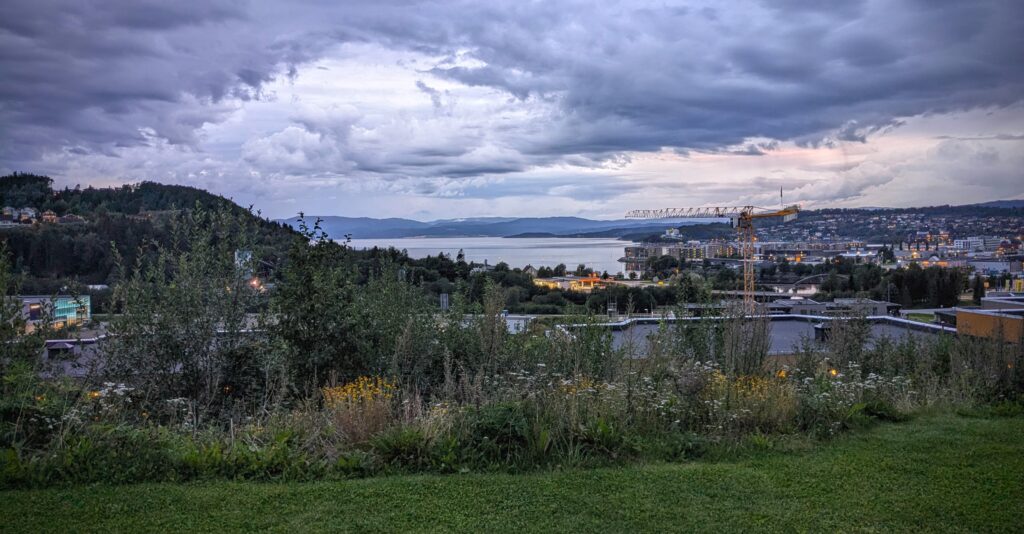
A modern growing city at the inner end of Trondheimsfjord, the 3rd longest fjord of Norway.
Like most of northern Norway almost all current buildings were built after 1945. During WWII Norway was heavily bombed by the Nazis and then occupied by them for 5 years. As the Russian army approached in 1945 and the Nazis retreated they destroyed everything of value, almost all buildings, sparing only a few churches.
We had a relaxing evening sitting on the patio in the cool breeze watching the arm of the yellow crane swing around, trying to discern if it was being manned, blown by the wind, or remotely programmed to swing into the wind!
August 14 Bodø (Day 322)
Another beautiful day to explore. Today we caught a late morning train for the 45 minute ride back to Bodø.
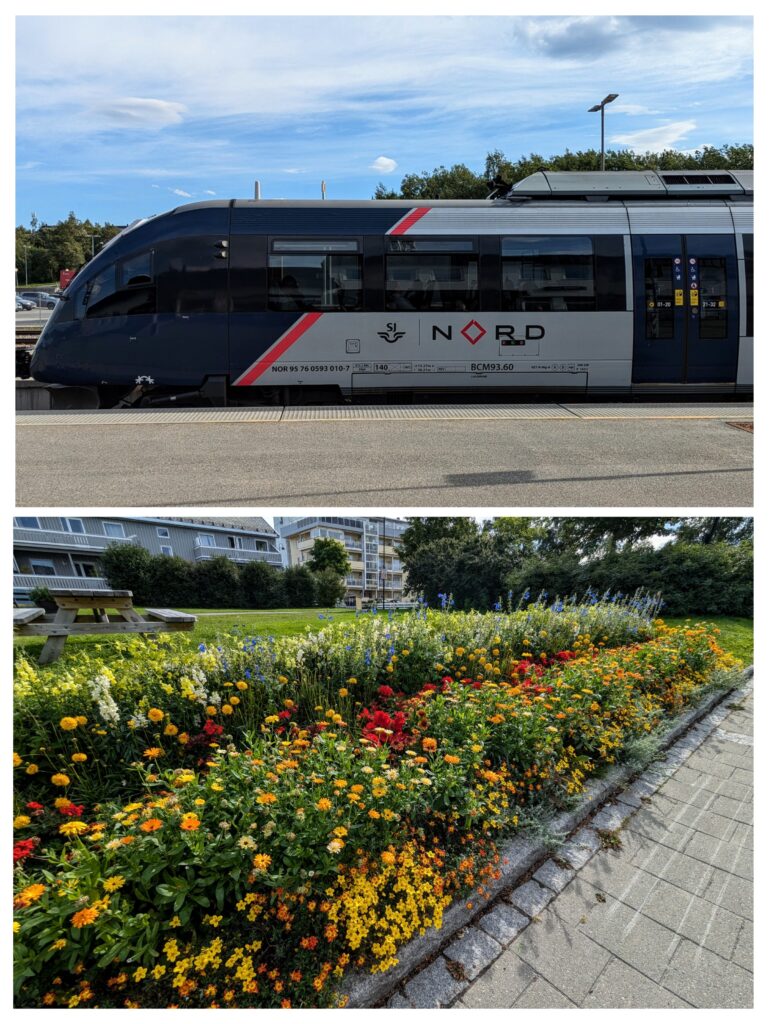
Bodø, like every Nordic town we’ve been in, has lush flower beds scattered around town!
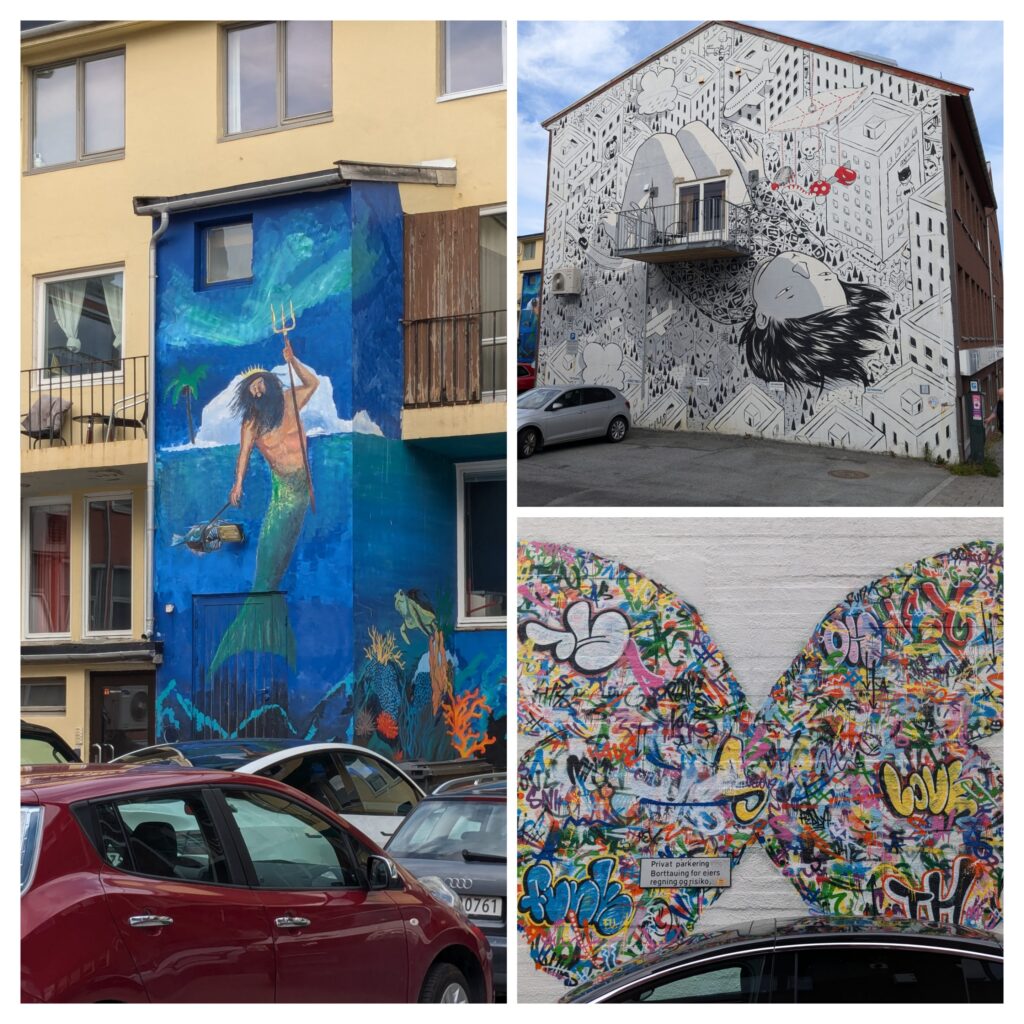
We spotted some of the murals on the map we picked up at the visitors center.
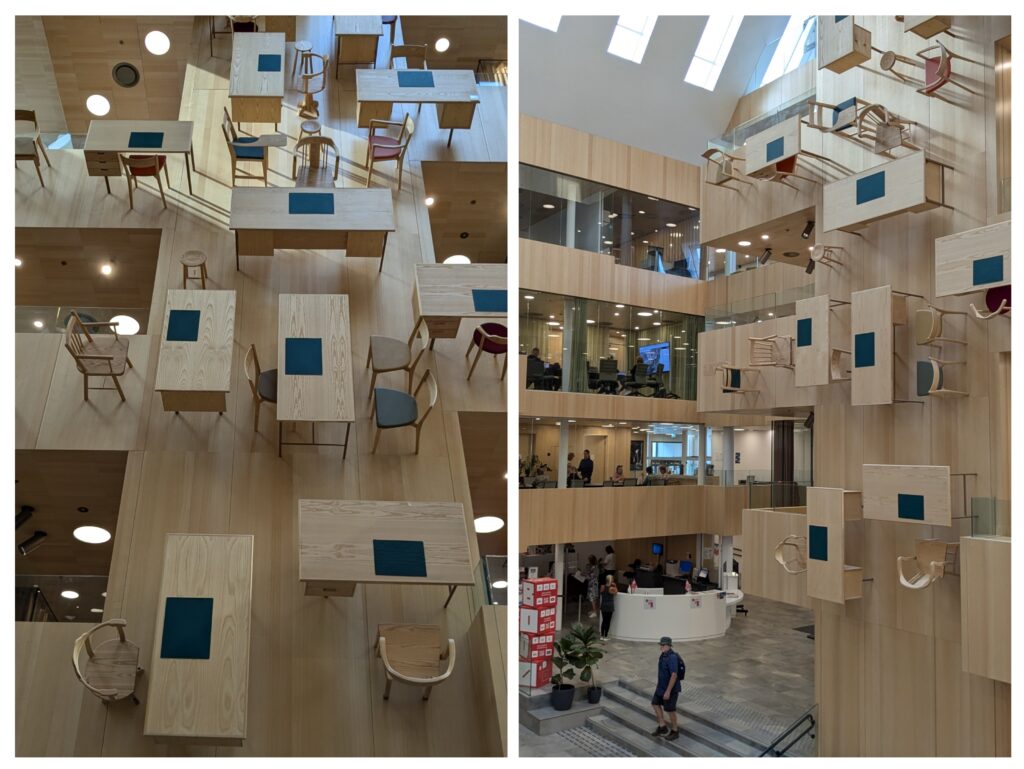
And we had to go into the town hall to see the unique architecture the host at the visitor center told us about! Optical illusion! The furniture is stuck on the wall!
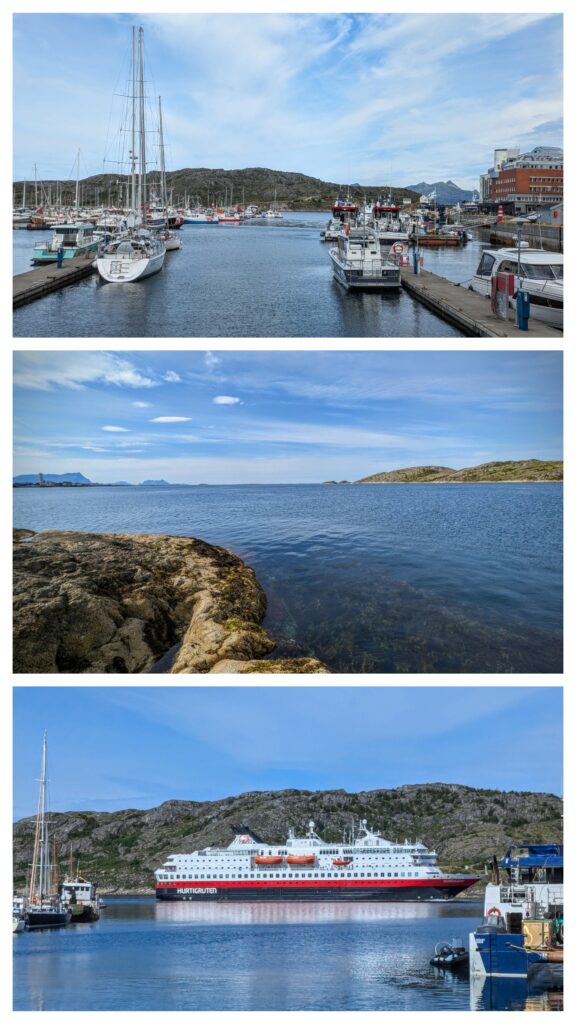
We walked to the harbor and out to the point at the harbor entrance. Coming back we saw the cruise ship enter the harbor. We have to check that out for a future trip!

Some quirky art work showcases some of the wildlife, the Sea Eagles and the Moose!
We caught a mid-afternoon train back to Fauske and enjoyed complimentary lattes and little chocolate squares that are available in the sleek, modern train cars.

We enjoyed the view of the fjord with the small boat houses and fishing boats that belong to the cabins hidden in the woods on the other side of the tracks.
Shortly after we returned, our hosts arrived back from a blueberry picking excursion in the mountains. Our host asked if we would like to go see the Saltstraumen Maelstrom that is about an hours drive away. We had actually heard about the whirlpools formed when the tide flows through a narrow channel in a fjord in Norway, but we didn’t know it was this close! We jumped at the chance to go see this phenomenon! We had a little time to get ready since it’s best to see it when the tide changes. Soon we were off, being driven back along the highway following the train route towards Bodø. Turning left onto a peninsula between the Saltfjorden and the Skjerstad fjord we came to a bridge over the narrow inlet from the sea to the fjord.

On the fjord side at water level it looked calm and people were fishing from the bank with a few fishing boats in the water.
We then drove over the bridge to the right, parked and walked up onto the bridge.
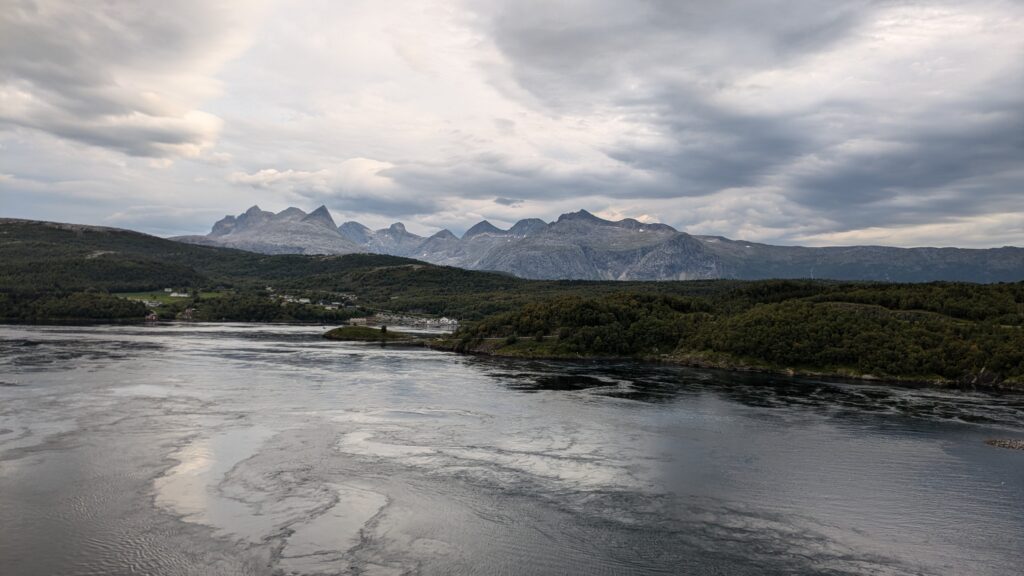
Looking down from the bridge you can see the water beginning to churn and swirls forming, as “Up to 400 million cubic metres (110 billion US gallons) of seawater forces its way through a 3 km (1.9 mi) long and 150 m (490 ft) wide strait every six hours.” This is considered the strongest tidal current in the world!
Saltstraumen wasn’t at its strongest today though, that would be at the full or new moon, we are at half moon now. For a good description here is a Youtube video of the Saltstraumen Maelstrom. Before we returned to Fauske our host took us to another venue which has roots in the Viking era. Tuvsjyen is a restaurant experience harkening to the stone age, where the food is cooked in a pit and served in an earthen hut on rough wood tables and benches.

Winter is actually a busier tourist season for this area with the Northern Lights on display!
We are lucky to be able to head back to Fauske and cook our dinner on an electric stove!





























